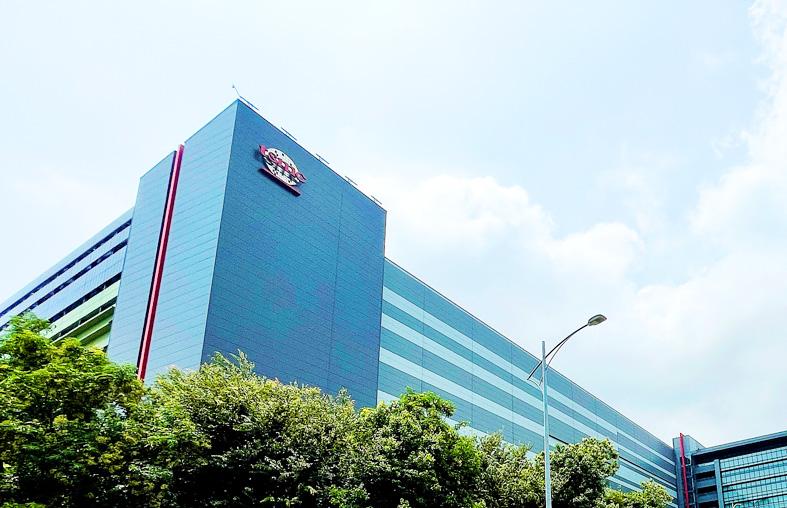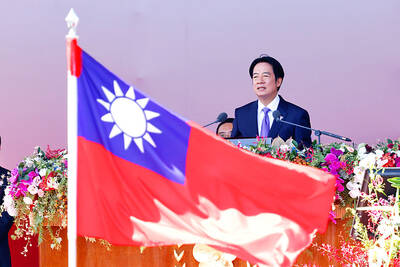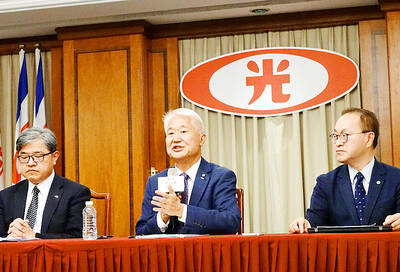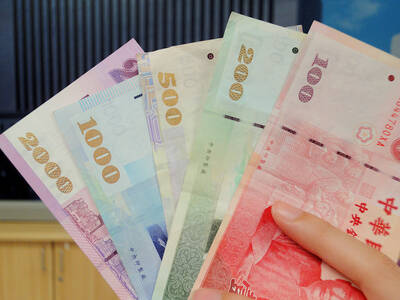Taiwan Semiconductor Manufacturing Co (TSMC, 台積電) yesterday raised its revenue growth forecast for this year to 35 percent after reporting record-high quarterly net profits.
Net profit last quarter hit NT$237.03 billion (US$7.93 billion), up 76.4 percent from a year earlier and 16.9 percent from the previous quarter.
The sole chip supplier of Apple Inc’s iPhones in April estimated that revenue would expand by a percentage in the mid-to-high 20s in US dollar terms this year, driven primarily by chips used in high-performance-computing (HPC) applications, such as servers and data centers.

Photo: Yimou Lee, Reuters
HPC applications have replaced smartphones to become the biggest revenue contributor to TSMC, accounting for about 43 percent last quarter.
For this quarter, revenue is forecast to expand to between US$19.8 billion and US$20.6 billion, from last quarter’s US$18.16 billion, TSMC said.
“Customers’ demand has continued to outpace TSMC’s capabilities this year. Even though they are going through inventory adjustments or have cut their orders, TSMC’s capacity has remained very tight,” TSMC chief executive C.C. Wei (魏哲家) told an online investors’ conference yesterday.
“Factory utilization remains very healthy. That is why we can keep our gross margin intact,” Wei said.
Gross margin is forecast to range from 57.5 percent to 59.5 percent this quarter, compared with a record-high 59.1 percent last quarter, the chipmaker said.
TSMC said the semiconductor supply chain is going through a new inventory correction period, which is expected to carry on through the first half of next year, in the face of faltering demand for smartphones, PCs and consumer electronics.
However, it does not expect customers in the HPC and premium smartphone segments to be overburdened by inventory, it said.
The latest inventory-driven downturn would be a “typical” downcycle, rather than a severe slump like the industry experienced in 2008, TSMC said.
Next year will be another year of growth, it said.
TSMC expects ‘its capacity utilization rate to remain healthy in 2023 and business to be less volatile and more resilient,” thanks to its stronger market position, product differentiation and technological advantages.
The chipmaker does not plan to cut its capital expenditure for this year, as it is upbeat about its long-term business outlook, fueled by increasing silicon content for each electronic device and growing demand for HPC, 5G smartphones and Internet-of-Thing devices.
Due to longer manufacturing equipment delivery time, TSMC expects this year’s capital spending to approach the lower end of its forecast range of US$40 billion to US$44 billion.
Manufacturing equipment used in leading-edge and mature technologies would be affected, it said.
TSMC said it has no plan to build new factories through any joint ventures with customers in the US. Its new US factory is still under construction.
The chipmaker is in discussions with local US governments over subsidies to narrow cost gaps, given higher-than-expected labor costs, TSMC chairman Mark Liu (劉德音) told investors yesterday.
TSMC yesterday reported that earnings per share last quarter climbed to NT$9.14, compared with NT$5.18 a year ago and NT$7.82 in the previous quarter.
Gross margin jumped to 59.1 percent last quarter, beating the chipmaker’s estimate of 58 percent. That was an improvement from 50 percent in the same period last year and 55.6 percent in the first quarter.

People can preregister to receive their NT$10,000 (US$325) cash distributed from the central government on Nov. 5 after President William Lai (賴清德) yesterday signed the Special Budget for Strengthening Economic, Social and National Security Resilience, the Executive Yuan told a news conference last night. The special budget, passed by the Legislative Yuan on Friday last week with a cash handout budget of NT$236 billion, was officially submitted to the Executive Yuan and the Presidential Office yesterday afternoon. People can register through the official Web site at https://10000.gov.tw to have the funds deposited into their bank accounts, withdraw the funds at automated teller

PEACE AND STABILITY: Maintaining the cross-strait ‘status quo’ has long been the government’s position, the Ministry of Foreign Affairs said Taiwan is committed to maintaining the cross-strait “status quo” and seeks no escalation of tensions, the Ministry of Foreign Affairs (MOFA) said yesterday, rebutting a Time magazine opinion piece that described President William Lai (賴清德) as a “reckless leader.” The article, titled “The US Must Beware of Taiwan’s Reckless Leader,” was written by Lyle Goldstein, director of the Asia Program at the Washington-based Defense Priorities think tank. Goldstein wrote that Taiwan is “the world’s most dangerous flashpoint” amid ongoing conflicts in the Middle East and Russia’s invasion of Ukraine. He said that the situation in the Taiwan Strait has become less stable

CONCESSION: A Shin Kong official said that the firm was ‘willing to contribute’ to the nation, as the move would enable Nvidia Crop to build its headquarters in Taiwan Shin Kong Life Insurance Co (新光人壽) yesterday said it would relinquish land-use rights, or known as surface rights, for two plots in Taipei’s Beitou District (北投), paving the way for Nvidia Corp to expand its office footprint in Taiwan. The insurer said it made the decision “in the interest of the nation’s greater good” and would not seek compensation from taxpayers for potential future losses, calling the move a gesture to resolve a months-long impasse among the insurer, the Taipei City Government and the US chip giant. “The decision was made on the condition that the Taipei City Government reimburses the related

FRESH LOOK: A committee would gather expert and public input on the themes and visual motifs that would appear on the notes, the central bank governor said The central bank has launched a comprehensive redesign of New Taiwan dollar banknotes to enhance anti-counterfeiting measures, improve accessibility and align the bills with global sustainability standards, Governor Yang Chin-long (楊金龍) told a meeting of the legislature’s Finance Committee yesterday. The overhaul would affect all five denominations — NT$100, NT$200, NT$500, NT$1,000 and NT$2,000 notes — but not coins, Yang said. It would be the first major update to the banknotes in 24 years, as the current series, introduced in 2001, has remained in circulation amid rapid advances in printing technology and security standards. “Updating the notes is essential to safeguard the integrity